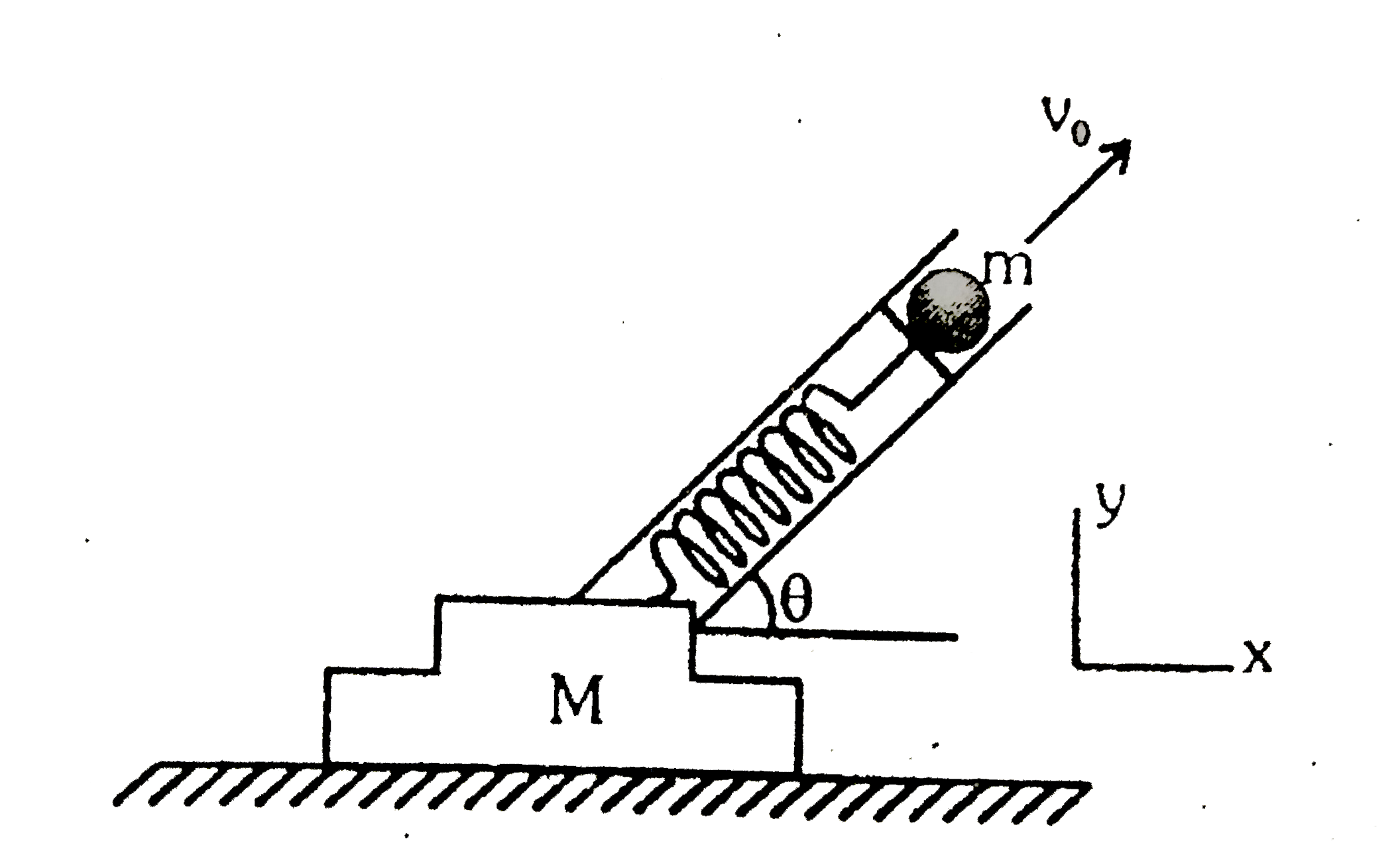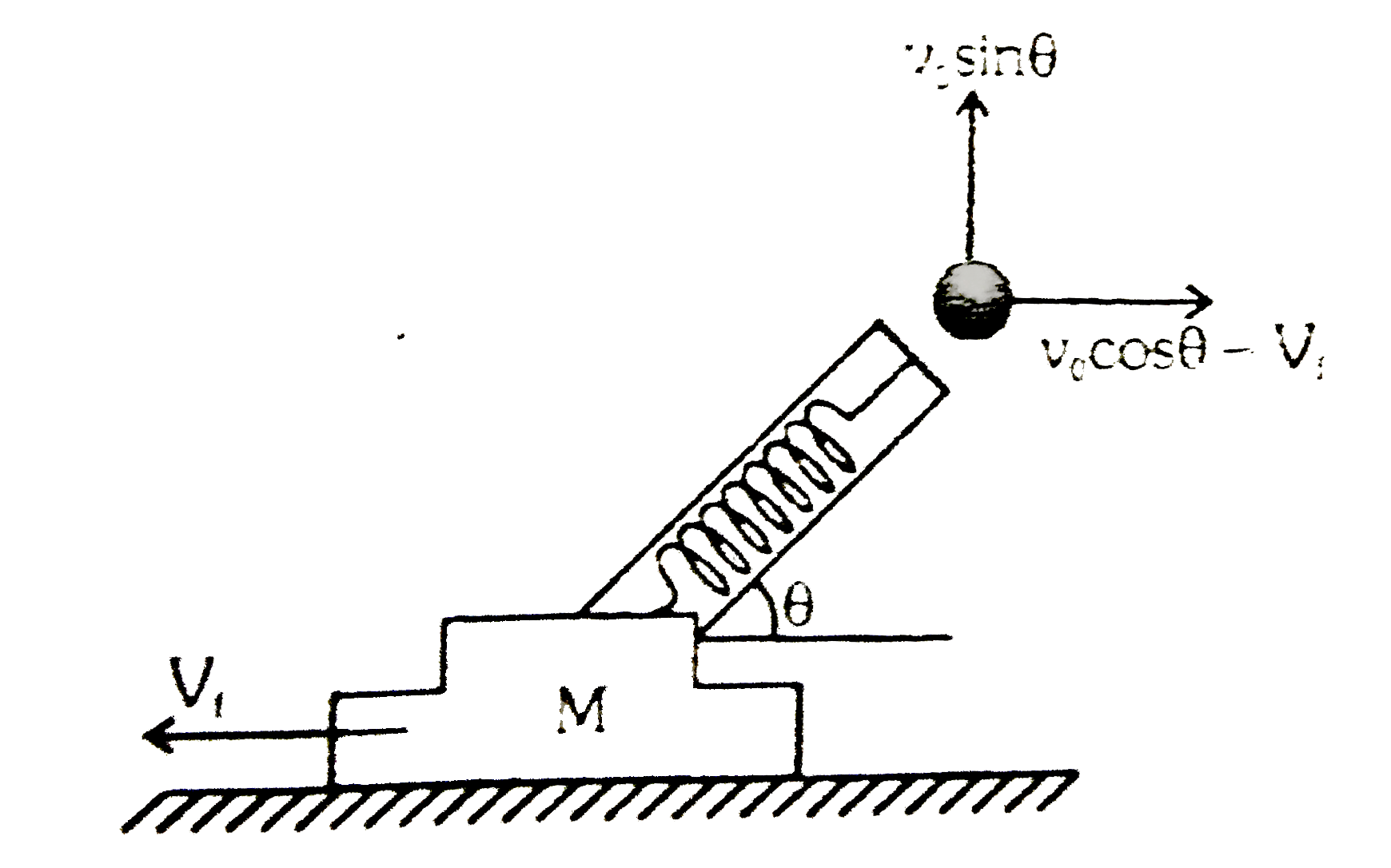A loaded spring gun, initially at rest on a horizontal frictionless surface, fires a marble at angle of elevation theta. The mass of the gun is M, the mass of the marble is m, and the muzzle velocity of the marble is v0. What is the final motion of the gun ?

Take the physical system to be the gun and marble. Gravity and the normal force of the table act on the system. Both these forces are vertical. Since there are no horizontal external forces, the x component of the vector equation F=dPdt is 0=dPxdt According to equation (1), Px is conserved:
Px.initial=Px.final
 Let the initial time be prior to firing the gun. Then Px.initial=0, since the system is initially at rest. After the marble has left the muzzle, the gun recoils with some speed V1, and its final horizontal momentum is MV1, to the left. FInding the final velocity of the marble involves a subtle point, however. Physically, the marble's accelaration is due to the force of the gun, and the gun's recoil is due to the reaction force of the marble. The gun stops accelerating once the marble leaves the barrel, so that at the instant the marble and the gun part company, the gun has its final speed Vf. At that same instant the speed of the marble relative to the gun is v0. Hence, the final horizontal speed of the marble relative to the tablet is v0cosθ−Vf. By conservation of horizontal momentum, we therefore have
Let the initial time be prior to firing the gun. Then Px.initial=0, since the system is initially at rest. After the marble has left the muzzle, the gun recoils with some speed V1, and its final horizontal momentum is MV1, to the left. FInding the final velocity of the marble involves a subtle point, however. Physically, the marble's accelaration is due to the force of the gun, and the gun's recoil is due to the reaction force of the marble. The gun stops accelerating once the marble leaves the barrel, so that at the instant the marble and the gun part company, the gun has its final speed Vf. At that same instant the speed of the marble relative to the gun is v0. Hence, the final horizontal speed of the marble relative to the tablet is v0cosθ−Vf. By conservation of horizontal momentum, we therefore have
0=m(v0cosθ−Vf)−MVf
or Vf=mv0cosθM+m
By using conversation of momentum we found the final motion of the system in a few steps. To show the advantage of this method, let us repeat the problem using Newton's laws directly. Let v(t) be the velocity of marble at time t and let V(t) be the velocity of the gun. While the marble is going fired, it is acted on by the spring, by gravity, and by friction forces with the muzzle wall. Let the net force on the marble be f(t). The x equation of motion for the marble is
mdvxdt=fx(t) Formal integration of equation (3) gives
mvx(t)=mvz(0)+∫t0fxdt
The external forces are all vertical, and therefore the horizontal force fx on the marble is due entirely to the gun. By newton's third law, there is a reaction force- fx on the gun due to the marble. No other horizontal forces acts on the gun, and the horizontal equation of motion for the gun is therefore MdVxdt=−fx(t), which can be integrated to give
MVx(t)=MVx(0)−∫t0fxdt we can eliminate the integral by combining equation (4) and (5).
MVx(t)+mvx(t)=MVx(0)+mvz(0)
we have rediscovered that the horizontal component of momentum is conserved. What about the motion of the center of mass? Its horizontal velocity is
Rx(t)=MVx(t)+mvx(t)M+m Using equation (6), the numerator can be rewritten to give
Rx(t)=MVx(0)+mvx(0)M+m=0
SInce the system is initially at rest. Rx is constant, as we expect.
We did not include the small force of air friction. Would the center of mass remain at rest if we had included it? The essential step in our derivation of the law of conservation of momentum was to use Newton's third law. Thus, conservation of momentum appears to be natural consequence of newtonian mechanics. It has been found, however, that conservation of momentum holds true even in areas where newtonian mechanics proves inadequate, including the realms of quantum mechanics and relativity. In addition, conservation of momentumcan be generalized to apply to systems like the electromagnetic field, which possess momentum but not mass. For these reasons, conservation of momentum is generally regarded as being more fundamental than newtonian mechanics. From the point of view, Newton's thitd law is a simple consequance of conservation of momentum for interacting particles. For our present purposes it is purely a matter of taste whether we wish to regard Newton's third law or conservation of momentum as more fundamental.
Topper's Solved these Questions
- BOOK - ALLENCHAPTER - CENTRE OF MASSEXERCISE - EXERCISE-I40videos
CENTRE OF MASS
- BOOK - ALLENCHAPTER - CENTRE OF MASSEXERCISE - EXERCISE-II43videos
CENTRE OF MASS
- BOOK - ALLENCHAPTER - BASIC MATHEMATICS USED IN PHYSICS &VECTORS EXERCISE - EXERCISE-IV ASSERTION & REASON11videos
BASIC MATHEMATICS USED IN PHYSICS &VECTORS
- BOOK - ALLENCHAPTER - ELASTICITY, SURFACE TENSION AND FLUID MECHANICSEXERCISE - Exercise 5 B (Integer Type Questions)3videos
ELASTICITY, SURFACE TENSION AND FLUID MECHANICS
Similar Questions
A shell of mass 0.02 kg is fird by a gun of mass 10 kg. If the muzzle speed of the shell is 600 ms−1, what is the recoil speed of the gun?
View SolutionA shell of mass 0.01 kg fired by a gun of mass 10 kg. If the muzzle speed of the shell is 50ms−1, what is the recoil speed of the gun?
View SolutionIf the range of a gun which fires a shell with muzzle speed V is R , then the angle of elevation of the gun is
View SolutionIf the range of a gun which fires a shell with muzzle speed V is R , then the angle of elevation of the gun is
View SolutionA bullet mass 10gm is fired from a gun of mass 1 kg . If the recoil velocity is 5 m/s, the velocity of the muzzle is
View SolutionA bullet mass 10gm is fired from a gun of mass 1 kg . If the recoil velocity is 5 m/s, the velocity of the muzzle is
View SolutionA bullet mass 10gm is fired from a gun of mass 1 kg . If the recoil velocity is 5 m/s, the velocity of the muzzle is
View SolutionIn an electron gun, the electrons are accelerated by the potential V. If the e is the charge and m is the mass of the electron, then the maximum velocity of these electrons will be
View SolutionA block of mass m is initially moving to the right on a horizontal frictionless surface at a speed v. It then compresses a spring of spring constant k. At the instant when the kinetic energy of the block is equal to the potential energy of the spring, the spring is compressed a distance of :
View SolutionA block of mass m moves on a horizontal rough surface with initial velocity v. The height of the centre of mass of the block is h from the surface. Consider a point A on the surface.
View Solution

